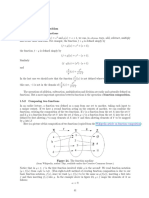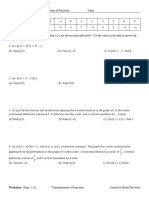1. Notes Topic 2.7 Composition of Functions
Uploaded by
venkasan0021. Notes Topic 2.7 Composition of Functions
Uploaded by
venkasan002Composite Functions
Sometimes in math we will plug a value for 𝑥 into a function and then use that output (answer) to plug into
another function. When we plug an output (𝑦) of one function back into another function, this is called a
composite function. Also known as Composition of Functions.
When working with composite functions there are _____ ways that we can write them.
1. 2.
We “read” these expressions as: _________________________ or _________________________.
Important Note: When working with composite functions, we start from the __________ first.
For example, if given 𝑓(𝑔(𝑥)):
1. Evaluate ________ first.
2. Then, use the answer from ________ and plug it into ________.
Example 1, 𝑓(𝑥) = 3𝑥 − 5 and 𝑔(𝑥) = 2𝑥 + 1, evaluate the following expressions:
a) 𝑓(𝑔(3)) = b) 𝑔(𝑓(3)) = c) 𝑓(𝑓(4)) =
Using the equations for 𝑓 and 𝑔 from Example 1, find the expressions for the following:
a) 𝑓(𝑔(𝑥)) = b) 𝑔(𝑓(𝑥)) = c) 𝑔(𝑔(𝑥)) =
Now, what happens when multiple functions are given?
Created by Bryan Passwater/Calc Medic
Edited by Michelle Sparks
d) (𝑘 ◦ 𝑓 ◦ ℎ)(1) e) 𝑘(𝑓(0))
Example 4:
You might also like
- Function: Edexcel IAL A Level Pure Mathematics 3 Revision NotesNo ratings yetFunction: Edexcel IAL A Level Pure Mathematics 3 Revision Notes28 pages
- 1.8: Combining Functions Composite Functions: Learning GoalsNo ratings yet1.8: Combining Functions Composite Functions: Learning Goals6 pages
- Q1 M1 GM Lesson 3 Composition of FunctionNo ratings yetQ1 M1 GM Lesson 3 Composition of Function15 pages
- Sgi 2.1 Function Operations and Composition of FunctionsNo ratings yetSgi 2.1 Function Operations and Composition of Functions2 pages
- Function Operations and Composition of FunctionsNo ratings yetFunction Operations and Composition of Functions34 pages
- Composite Functions: Maryam Mozayan Chinica Madurkar Modita Jain Kanishk Jena Parthvi SachanNo ratings yetComposite Functions: Maryam Mozayan Chinica Madurkar Modita Jain Kanishk Jena Parthvi Sachan18 pages
- Training Course 9 Senior Functions and TrigonometryNo ratings yetTraining Course 9 Senior Functions and Trigonometry32 pages
- 1.7 Combinations of Functions; Composite FunctionsNo ratings yet1.7 Combinations of Functions; Composite Functions12 pages
- Functions: Ecc 3001 Engineering Mathematics 1No ratings yetFunctions: Ecc 3001 Engineering Mathematics 139 pages
- 1.5 Function Composition: (From Wikipedia, Author Tlep, Available Under The Creative Commons License.)No ratings yet1.5 Function Composition: (From Wikipedia, Author Tlep, Available Under The Creative Commons License.)5 pages
- Ch 4 - Combining Functions Notes and ExamplesNo ratings yetCh 4 - Combining Functions Notes and Examples14 pages
- Function Operationsand Compositionof FunctionsNo ratings yetFunction Operationsand Compositionof Functions36 pages
- c03CompositeFunctionsTransformationsAndInverses Holiday HomeworkNo ratings yetc03CompositeFunctionsTransformationsAndInverses Holiday Homework56 pages
- Function Operations and Composition of FunctionsNo ratings yetFunction Operations and Composition of Functions41 pages
- Inverse Trigonometric Functions (Trigonometry) Mathematics Question BankFrom EverandInverse Trigonometric Functions (Trigonometry) Mathematics Question BankNo ratings yet
- 3. Extra Practice Math Medic HW 2.15 KeyNo ratings yet3. Extra Practice Math Medic HW 2.15 Key1 page
- 4. Extra Practice Topic 2.1 Change in arithmetic and geometric sequencesNo ratings yet4. Extra Practice Topic 2.1 Change in arithmetic and geometric sequences2 pages
- Calc Medic Guided Notes (Topics 1.1-1.6)No ratings yetCalc Medic Guided Notes (Topics 1.1-1.6)19 pages
- 6. (FlippedMath) Unit 2A Corrective Assignment with KeyNo ratings yet6. (FlippedMath) Unit 2A Corrective Assignment with Key9 pages
- 3. Worksheet A Topics 1.13 - 1.14 Modeling Functions and ApplicationsNo ratings yet3. Worksheet A Topics 1.13 - 1.14 Modeling Functions and Applications3 pages
- Extra Practice Topic 1.12 Transformations of FunctionsNo ratings yetExtra Practice Topic 1.12 Transformations of Functions11 pages
- Notes Key Topic 1.6 Polynomial Functions and End BehaviorNo ratings yetNotes Key Topic 1.6 Polynomial Functions and End Behavior3 pages
- (FlippedMath) Unit 1A Corrective Assignment (With Answers)No ratings yet(FlippedMath) Unit 1A Corrective Assignment (With Answers)6 pages
- Extra Practice Topic 1.4 Graphing Calculators and ExtremaNo ratings yetExtra Practice Topic 1.4 Graphing Calculators and Extrema2 pages
- Extra Practice Key Topic 1.4 Graphing Calculators and ExtremaNo ratings yetExtra Practice Key Topic 1.4 Graphing Calculators and Extrema1 page
- Calculating Slope Practice Topic 1.2 AROCNo ratings yetCalculating Slope Practice Topic 1.2 AROC2 pages
- Notes Key Topic 1.4 Polynomial Functions - Rates of ChangeNo ratings yetNotes Key Topic 1.4 Polynomial Functions - Rates of Change3 pages
- (FlippedMath) Extra Practice 2.1 (W - Key)No ratings yet(FlippedMath) Extra Practice 2.1 (W - Key)4 pages
- Four Corners Topic 1.2 Average Rate of ChangeNo ratings yetFour Corners Topic 1.2 Average Rate of Change1 page
- AP Physics Performance Tasks InstructionsNo ratings yetAP Physics Performance Tasks Instructions2 pages
- AP World History Review - Name The Effects (1200-1450) (Unit 2 Only)No ratings yetAP World History Review - Name The Effects (1200-1450) (Unit 2 Only)19 pages
- SANJEEV VENKATESH - Animal Farm Ch. 1-2 Analysis-Appeals and ClaimNo ratings yetSANJEEV VENKATESH - Animal Farm Ch. 1-2 Analysis-Appeals and Claim1 page

























































































